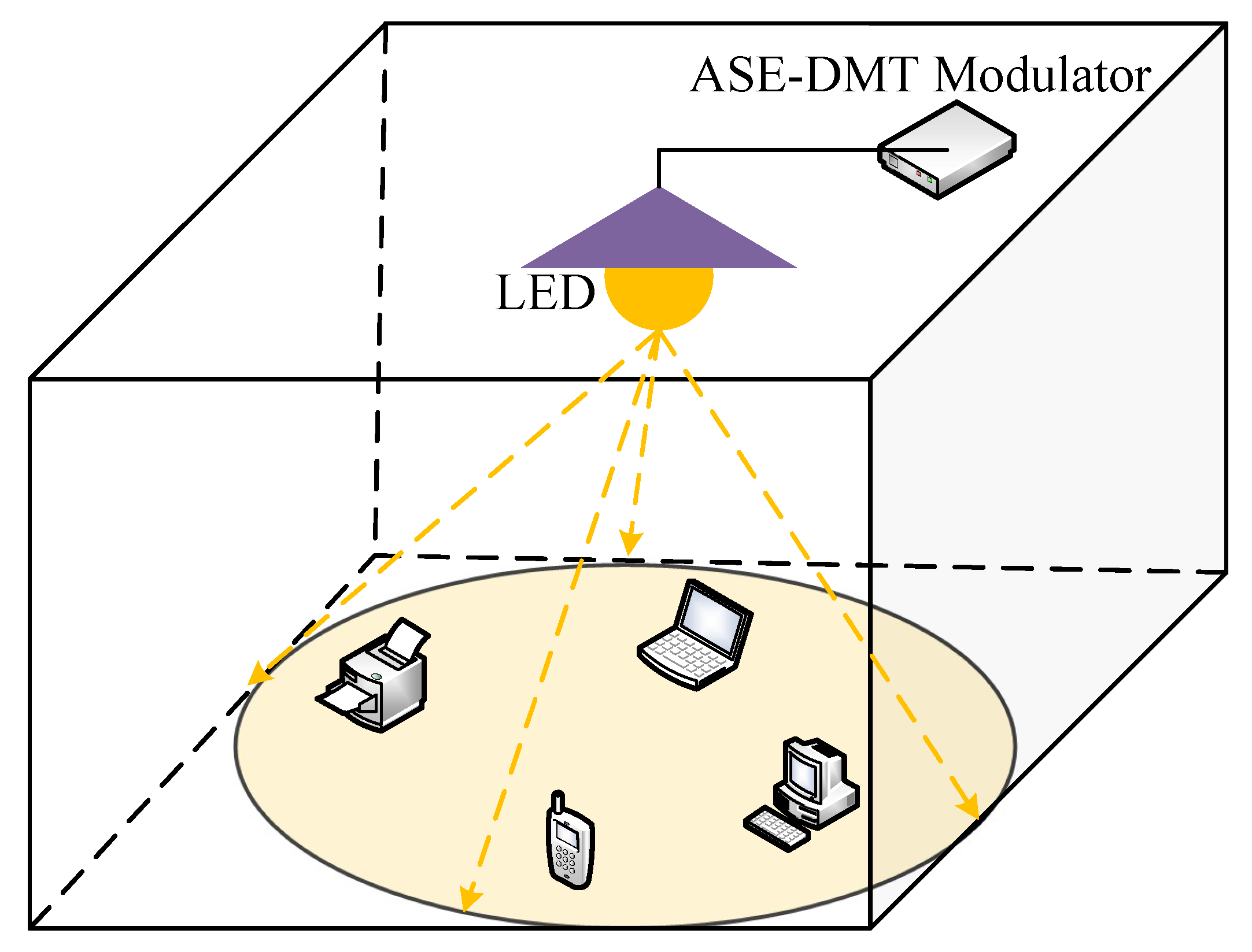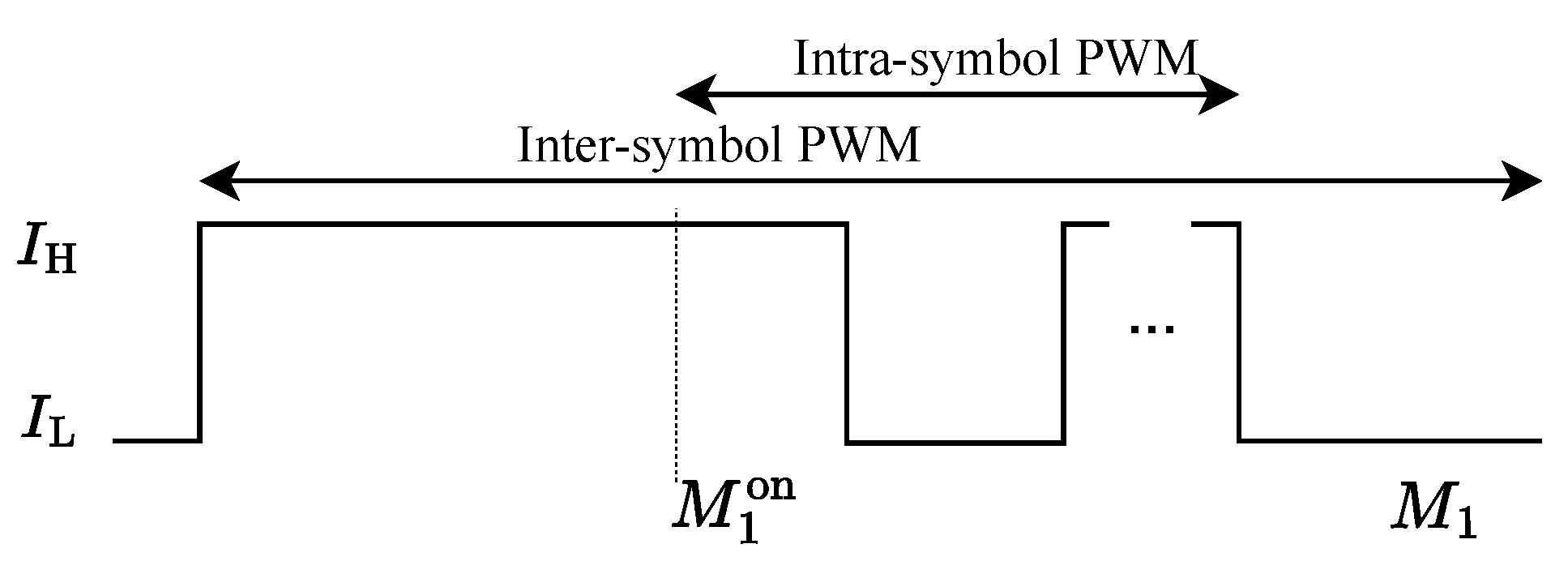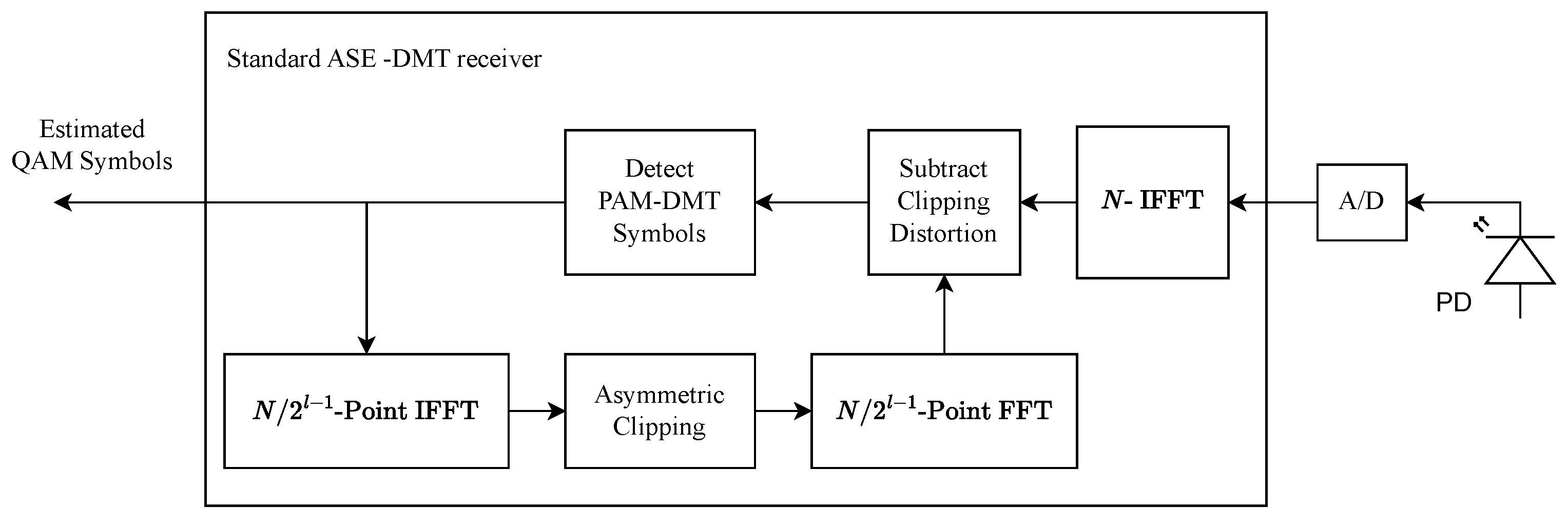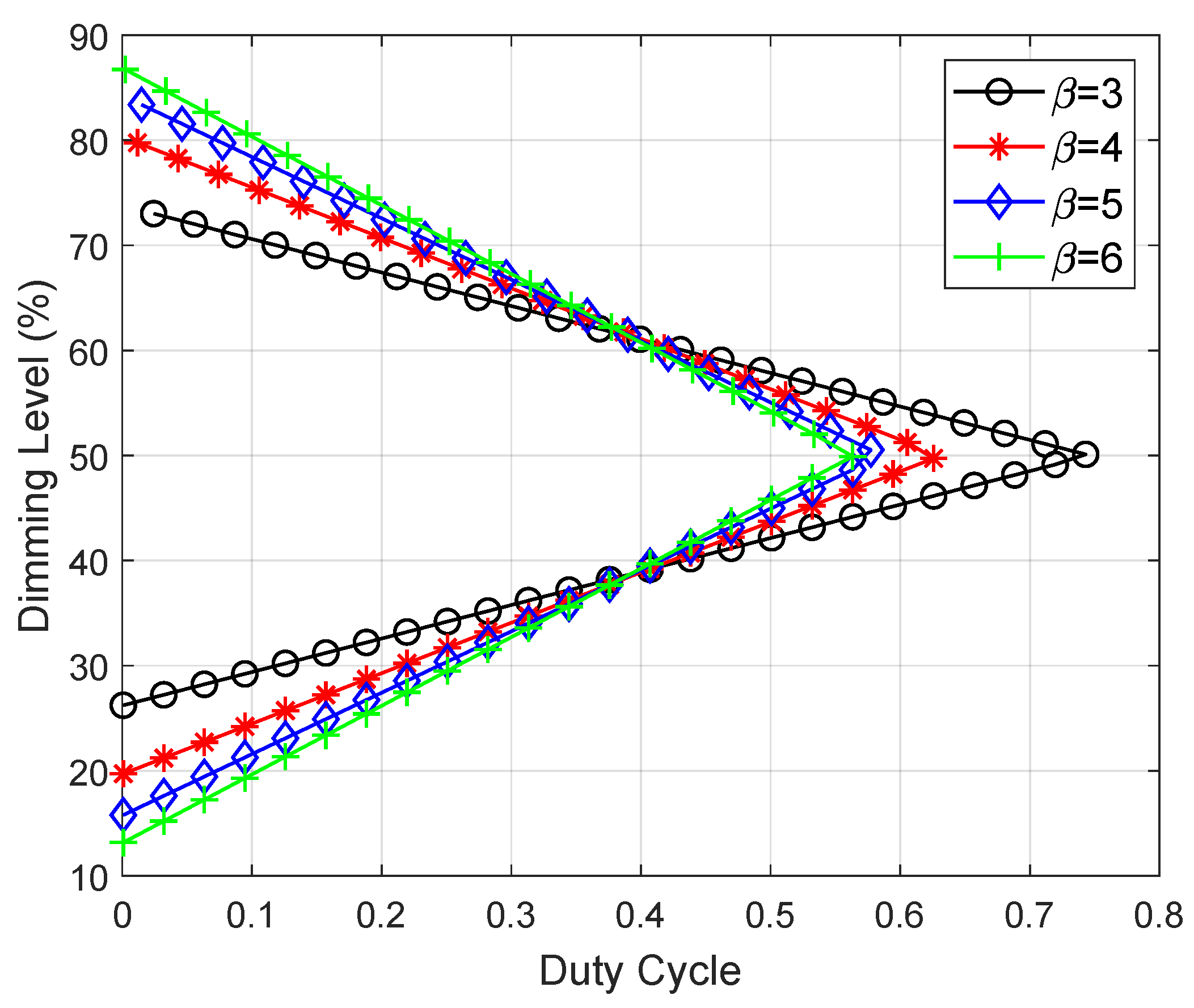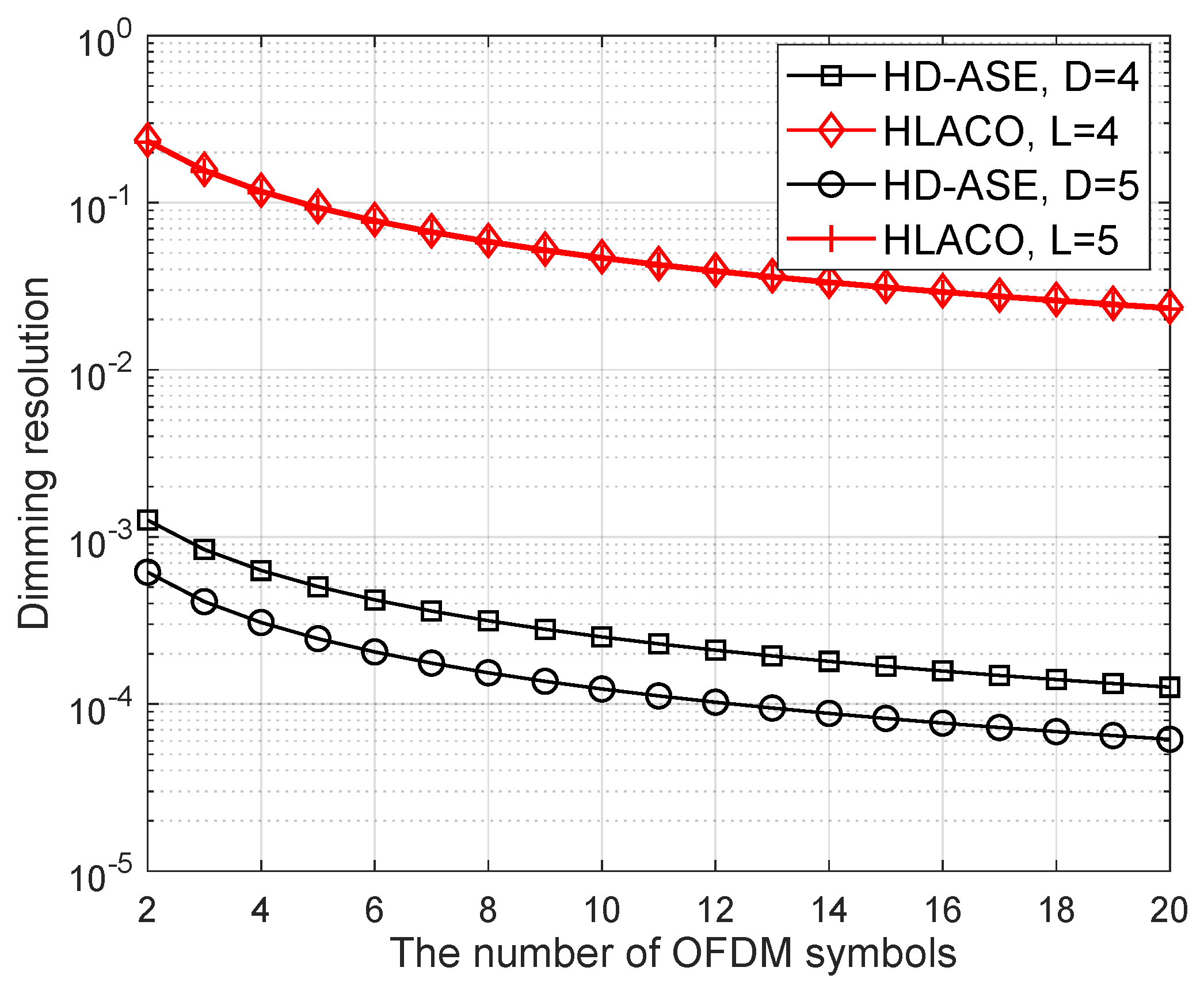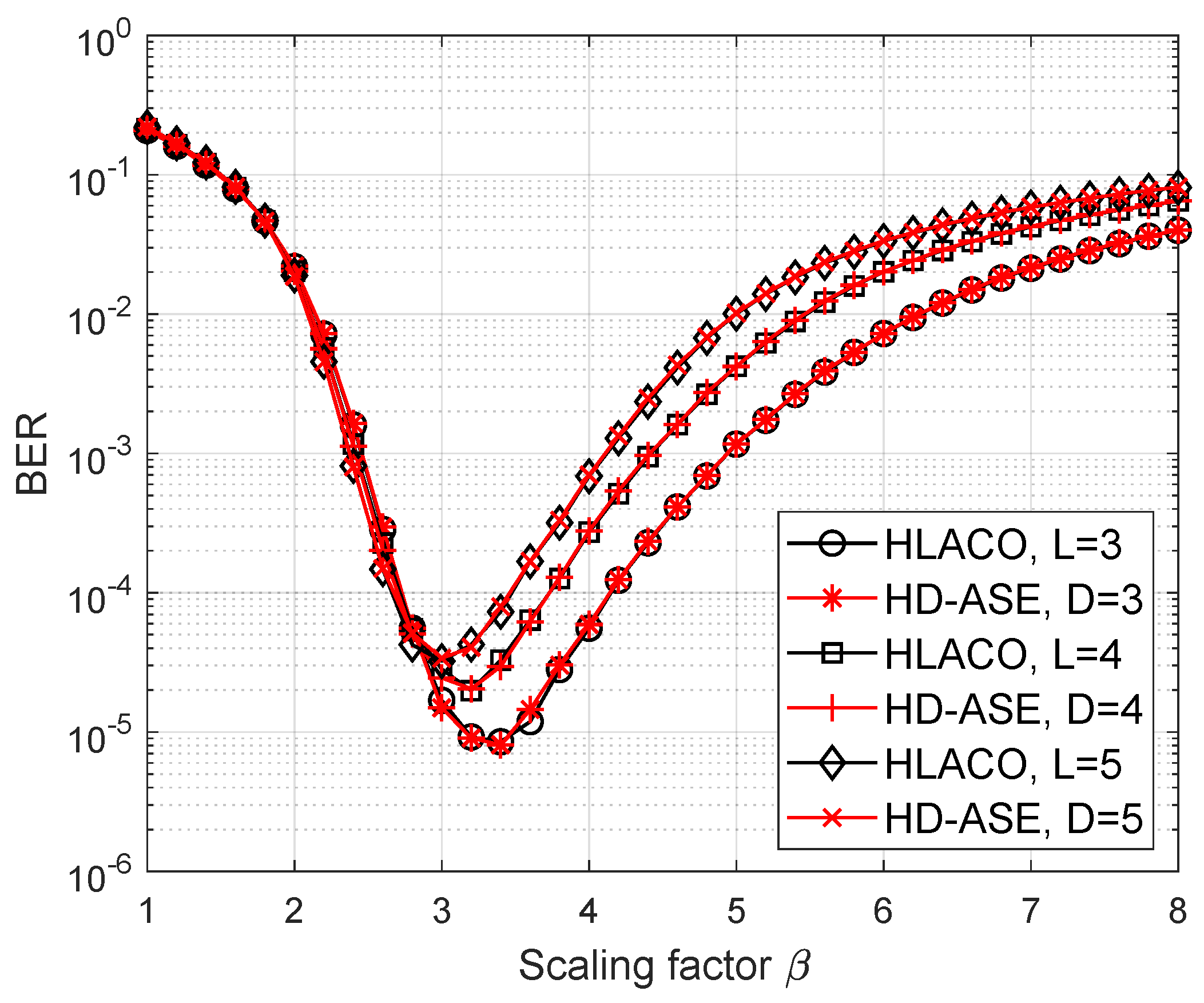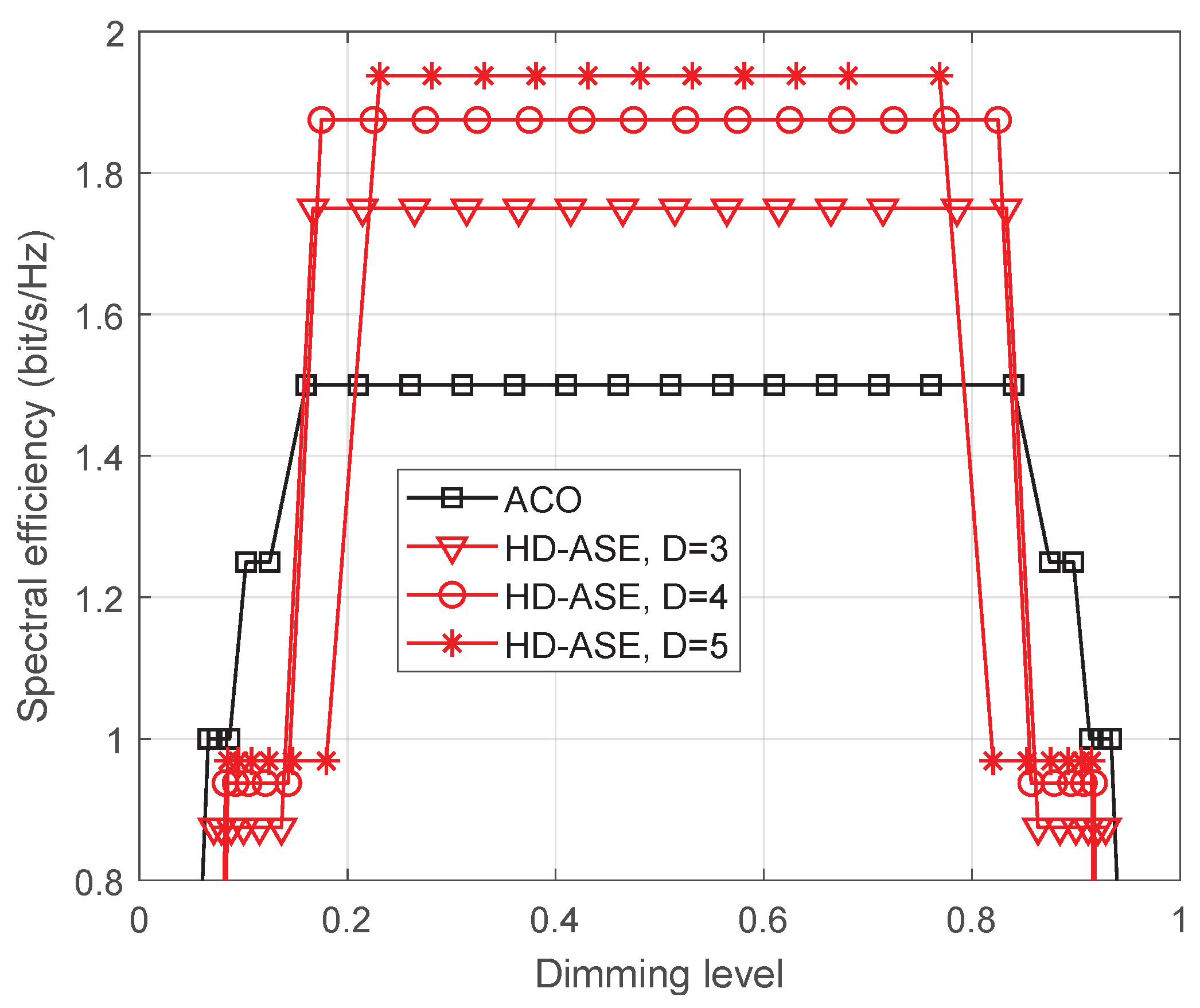1. Introduction
Given the accelerated advancement of worldwide information technology and the growing demand for high-speed communication, traditional radio frequency (RF) communication is facing the challenge of spectrum congestion [
1,
2]. Visible-light communication (VLC) has gained prominence as a groundbreaking technology, leveraging the vast potential of the visible-light spectrum to provide abundant spectral resources, ultra-high transmission rates, enhanced security, and inherent immunity to electromagnetic interference. Relying on these advantages, VLC has been widely explored in numerous application scenarios, such as indoor wireless networks, the internet of things, intelligent transportation, and so on [
3,
4,
5,
6]. Acting as one of the fundamental technologies envisioned in 6G communication, VLC is expected to be instrumental in shaping the future of wireless communication [
7,
8,
9].
In VLC systems, orthogonal frequency-division multiplexing (OFDM) has been recognized as a dominant modulation approach that enables high-rate data transmission [
10,
11]. This advanced modulation exhibits robust adaptability to the varying characteristics of optical channels by efficiently distributing information across multiple subcarriers. While the transmitted OFDM signal is complex and bipolar in conventional RF communication, a non-negative and real-valued OFDM signal is required in VLC using intensity modulation with direct detection (IM/DD) [
12]. For the purpose of satisfying the requirements of non-negativity and a real value, a range of optical OFDM (O-OFDM) schemes have been developed. In these schemes, the real-valued signal is generated by applying Hermitian symmetry. To ensure non-negativity, a straightforward solution is to add a direct current (DC) bias, referred to as DC offset OFDM (DCO-OFDM) [
13]. However, the additional DC bias of DCO-OFDM leads to degraded power efficiency [
14]. The other well-known schemes are asymmetrically clipped O-OFDM (ACO-OFDM) and pulse-amplitude-modulated discrete multi-tone (PAM-DMT) architectures, which both directly remove the negative parts according to the properties of the Fourier transform [
15,
16]. However, the spectral efficiency of both ACO-OFDM and PAM-DMT architectures remains limited, as just half of the available subcarrier resources are utilized [
17].
In order to enhance the spectral efficiency, advanced hybrid O-OFDM schemes leveraging the simultaneous transmission of multiple O-OFDM signals have been designed. Popular hybrid O-OFDM schemes include hybrid ACO-OFDM (HACO-OFDM), layered ACO-OFDM (LACO-OFDM), augmented spectral-efficiency discrete multi-tone (ASE-DMT) architectures, etc. [
18,
19,
20]. In HACO-OFDM, the ACO-OFDM and PAM-DMT signals are concurrently transmitted, preserving the exceptional power efficiency of ACO-OFDM while attaining higher spectral efficiency. However, the real parts of the even-indexed subcarriers remain underutilized in HACO-OFDM. Compared to HACO-OFDM, LACO-OFDM, and ASE-DMT architectures can fully exploit the subcarrier resources using multiple superimposed O-OFDM signals, and these are deemed to be promising spectral-efficient modulation schemes in VLC [
21].
In VLC systems, light-emitting diodes (LEDs) are the key devices that provide both illumination and data transmission capabilities [
22]. This dual functionality necessitates that LEDs not only provide high-quality illumination but also enable efficient data transmission. Dimming control is essential for achieving high-quality illumination, as it enables the adjustment of the brightness of LEDs according to user requirements. Therefore, dimming control is regarded as a critical part of VLC and has been incorporated into VLC-related standards [
23,
24]. There are generally two kinds of dimming techniques widely used in illumination, namely continuous current reduction (CCR) and pulse-width modulation (PWM). In CCR, the brightness of LEDs is controlled by varying the forward current. However, the wavelength of the emitted light will be altered when directly changing the forward current, leading to noticeable color shifts. Compared to CCR, PWM is the preferred solution in industry for dimming LEDs owing to the advantages of its high energy efficiency, exceptional dimming linearity, reduced color shift, and so on [
25].
In order to enable both dimming control and efficient communication, dimmable O-OFDM schemes based on PWM have become a significant research focus, such as in the exciting work in [
26,
27,
28,
29,
30]. In these studies, the PWM and O-OFDM signals were optimally designed to enable seamless integration. Meanwhile, hybrid O-OFDM schemes were employed to achieve high spectral efficiency. However, integrating PWM dimming with OFDM-based transmission is a highly challenging task since dimming control should not influence communication transmission. To address this, the PWM period was set to a multiple of the O-OFDM symbol duration, and the duty cycle of PWM was adjusted by the step of O-OFDM symbol period in the existing work [
27,
28,
29,
30]. In this way, the PWM signal remained constant during one OFDM symbol so that the transmitted signals were not contaminated. Nevertheless, the dimming resolution in the existing studies was limited, which resulted in a failure to achieve high-quality seamless brightness control. Meanwhile, the detection process was sensitive to the dimming information in the existing work, further increasing the implementation complexity.
In this paper, we propose a novel high-resolution dimmable ASE-DMT (HD-ASE-DMT) scheme for VLC systems, which supports spectral-efficient communication while, at the same time, providing high-resolution dimming control. The main contributions of the paper are summarized as follows:
- 1.
In contrast to the conventional PWM scheme with low dimming resolution, a hybrid PWM dimming mechanism was first conceived by integrating inter-symbol PWM with intra-symbol PWM to enable a flexible and high-resolution two-tier dimming control. Moreover, the proposed hybrid PWM signal does not introduce any interference with ASE-DMT.
- 2.
Furthermore, in order to achieve the seamless integration of the hybrid PWM and ASE-DMT, a reconstructed process was designed, which ensured that the proposed HD-ASE-DMT operates within the limited dynamic range of LEDs. Compared to the existing dimmable modulation schemes, the detection process is totally insensitive to the dimming information in HD-ASE-DMT, thus reducing the implementation complexity.
- 3.
Simulation results demonstrated that the dimming level of the proposed HD-ASE-DMT can be linearly adjusted by varying the duty cycle. Moreover, the dimming resolution of the proposed HD-ASE-DMT was improved by two orders of magnitude compared to the existing dimming scheme. Meanwhile, a 29.3% improvement in spectral efficiency was observed for HD-ASE-DMT, thus validating its high transmission efficiency.
The remainder of this paper is organized as follows:
Section 2 introduces the theoretical foundation of ASE-DMT.
Section 3 describes the proposed two-tier dimming control mechanism, including the inter-symbol and intra-symbol PWM techniques.
Section 4 presents the integration of high-precision dimming into the ASE-DMT framework.
Section 5 provides simulation results, and
Section 6 concludes the paper.
2. VLC Transmission Using ASE-DMT
In a VLC system, an LED installed on the ceiling can simultaneously provide both communication and illumination, as illustrated in
Figure 1. The light emitted by the LED is driven by a signal generated by the spectral-efficient ASE-DMT modulator. In ASE-DMT, subcarrier resources are divided into multiple depths, each corresponding to a distinct PAM-DMT signal. Multiple PAM-DMT signals are superimposed for simultaneous transmission to improve spectral efficiency. Meanwhile, benefiting from the well-designed superimposed architecture, ASE-DMT maintains the high power efficiency of PAM-DMT. To be specific, the input bit stream is divided into
D depths at the transmitter. The first depth adopts standard PAM-DMT modulation, in which
M-PAM symbols occupy the imaginary parts of the subcarriers, and the real parts remain zero:
where
denotes the
M-PAM symbol at the
k-th subcarrier for the first depth. To ensure real-valued time-domain signals, the Hermitian symmetry is required, i.e.,
for
. In ASE-DMT, the residual real parts of subcarriers are leveraged by depth
. Specifically, the data streams of depth
are allocated to the real parts of the
-th subcarriers, which is given by
where
represents the
M-PAM symbol at the
k-th subcarrier of depth
d, and
.
After allocating PAM symbols to all depths in the frequency domain, inverse fast Fourier transform (IFFT) operations are executed to generate time-domain PAM-DMT signals, which can be converted to non-negative ones by directly using a zero-clipping operation. Furthermore, multiple clipped PAM-DMT signals are superimposed to produce the ASE-DMT signal, which is expressed as
where
is the zero-clipping operation,
denotes PAM-DMT signal at depth
d,
represents the ASE-DMT signal.
3. Hybrid PWM with High Dimming Resolution
Thanks to the linear adjustment of LED brightness, PWM is widely used in VLC systems to achieve dimming control. In order to enable both communication and illumination, it is essential to integrate the PWM signal with the O-OFDM signal for simultaneous transmission, resulting in dimmable O-OFDM. However, existing PWM-based dimmable O-OFDM schemes suffer from low dimming resolution since the duty cycle of PWM needs to be adjusted in discrete steps corresponding to the O-OFDM symbol period to avoid disrupting the transmitted information. To overcome this limitation, a hybrid PWM dimming architecture with high dimming resolution is proposed for spectrally efficient ASE-DMT. The hybrid architecture consists of a two-tier dimming control:
First-tier dimming employs an inter-symbol PWM scheme, which achieves brightness control at the level of the O-OFDM symbol period.
Second-tier dimming relies on an intra-symbol PWM scheme, which can be adjusted by the step size of the sampling interval.
Thanks to the hybrid architecture of the two-tier dimming control, a high dimming resolution can be achieved. Meanwhile, the transmitted information is free from the interference of the two-tier dimming control, which guarantees the seamless integration of dimming control and data transmission.
3.1. Design of Inter-Symbol PWM
In the first-tier dimming control, the PWM period is set to be an integer multiple of the O-OFDM symbol period, and the duty cycle is adjusted by the step size of the O-OFDM symbol period, resulting in an inter-symbol PWM mechanism. As a further benefit, the amplitude of the inter-symbol PWM signal remains constant so that the information transmission of ASE-DMT is free of interference.
Let
denote the O-OFDM symbol period of ASE-DMT. Furthermore, the inter-symbol PWM period is set to
, where
denotes the number of O-OFDM symbols occupied by a single PWM period. Accordingly, the inter-symbol PWM signal can be expressed as
where
denotes the number of O-OFDM symbols corresponding to the “ON” state of PWM,
and
are the LED’s maximum and minimum driving currents, respectively. As illustrated in
Figure 2, the duty cycle
of the inter-symbol PWM is given by
It is observed from Equation (
5) that the resolution of PWM depends on
. Since a relatively large value of
could lead to LED flicker,
has to be set to a moderate value, which limits the dimming resolution of the inter-symbol PWM.
3.2. Design of Intra-Symbol PWM
In the second-tier dimming control, an intra-symbol PWM mechanism is designed, in which one O-OFDM symbol period of ASE-DMT spans multiple PWM periods. The duty cycle of the intra-symbol PWM can be finely tuned in discrete increments corresponding to the sampling interval. Furthermore, no interference of PWM is imposed on the transmitted information of ASE-DMT owing to the well-designed time-domain architecture.
In ASE-DMT, the first depth uses the imaginary part of subcarriers for data transmission. For depth
, the real parts of the
-th subcarriers are exploited to transmit PAM symbols, where
, and
D denotes the total number of depths. The subcarriers unused for data transmission are indexed by
. Therefore, in order to prevent interference with ASE-DMT, the intra-symbol PWM signal is designed to occupy the real parts of these unused subcarriers. According to the properties of the Fourier transform, the intra-symbol PWM signal, denoted by
, should satisfy the following symmetries:
The FFT operation can be performed on
to prove Equation (
6). To be specific, given that
, the FFT output of
is expressed as
One can observe that
is located at the
-th subcarriers. Given that
, we further have
Therefore, it is concluded that the intra-symbol PWM signal satisfying Equation (
6) does not interfere with the transmitted information of ASE-DMT. According to the time-domain properties in Equation (
6), the intra-symbol PWM signal
for
is first defined as
where
represents the number of sampling points during the “ON” state of PWM. Furthermore, the intra-symbol PWM signal over the entire OFDM symbol period can be derived based on Equation (
6). To be specific, by defining the intra-symbol PWM period and sampling interval as
and
, respectively, the corresponding continuous-time PWM signal over the entire OFDM period is expressed as
where
. Let the number of sampling points within one intra-symbol PWM period be denoted as
. The duty cycle
of the intra-symbol PWM signal is defined as
It is observed from Equation (
11) that liner dimming control can be achieved by adjusting
. The waveform of the intra-symbol PWM is illustrated in
Figure 3.
3.3. Hybrid PWM Dimming Control
In this section, a hybrid PWM dimming mechanism is further designed by integrating inter-symbol PWM with intra-symbol PWM to enable the flexible two-tier dimming control. Owing to this flexible dimming strategy, high dimming resolution is obtained while ensuring that the legitimately transmitted symbols of ASE-DMT remain uncontaminated by the dimming process.
In the proposed hybrid PWM scheme, the inter-symbol PWM with a period of
O-OFDM symbols is employed for the first-tier dimming, where the “ON” state spans the first
symbols. In order to support high dimming resolution, the intra-symbol PWM is further adopted to achieve the second-tier dimming during the
-th symbol period. Therefore, the hybrid PWM signal
is defined as
Furthermore, the overall duty cycle
of the hybrid PWM signal is calculated as
It is observed that the duty cycle
can be adjusted by both
and
. Moreover, the adjustment precision of
for the proposed hybrid PWM signal is equal to
. In the conventional dimming scheme, the duty cycle of PWM is adjusted by the step of the O-OFDM symbol period to avoid interference, thus leading to the adjustment precision of
. Since we have
, the adjustment precision of the proposed hybrid PWM is much higher than that of the conventional dimming scheme. Meanwhile, both inter-symbol and intra-symbol PWM signals of the hybrid PWM do not affect the transmitted symbols of ASE-DMT. As a result, an interference-free dimming control with high resolution can be supported by the proposed hybrid PWM.Furthermore, the waveform of the hybrid PWM is further illustrated in
Figure 4.
5. Simulation Results and Discussion
The performance of the proposed HD-ASE-DMT is systematically evaluated through multi-dimensional simulations, focusing on both dimming performance and communication metrics. The simulation framework incorporates an O-OFDM-based VLC system with
subcarriers. For LED current characterization, the dynamic current range is established between
A (minimum dimming state) and
A (maximum dimming state). To quantitatively evaluate the photometric nonlinearity of LEDs, we introduce the scaling factor, defined as
, where
is the variance of O-OFDM signals [
29,
30].
Figure 7 illustrates the dimming levels of the proposed HD-ASE-DMT at various values of the duty cycle. The dimming level exhibits a linear relationship with the duty cycle for
and
, respectively. Given the duty cycle of 0.095, dimming levels of
,
,
and
are achieved for
while dimming levels of
,
,
and
are achieved for
when
is set to 3, 4, 5, and 6, respectively. It is observed that as the scaling factor increases, the dimming level diminishes for
while escalating for
. Furthermore, a dimming range of
is obtained by
while the dimming range is expanded to
for
. Therefore, an expanded dimming range can be obtained for a larger value of scaling factor
.
Furthermore, the dimming resolution of the proposed HD-ASE-DMT is provided in
Figure 8, where the conventional HLACO-OFDM based on the inter-symbol PWM is also included for comparison. It is seen that the dimming resolution gradually improves as the number of O-OFDM symbols within the PWM period increases. However, simply increasing the number of O-OFDM symbols does not lead to a substantial enhancement in dimming resolution.Moreover, a large number of O-OFDM symbols may introduce potential risks of perceptible luminous flicker. When the number of OFDM symbols is set to 10, the dimming resolutions achieved by HD-ASE-DMT with
and HLACO-OFDM with
are 2.5 ×
and 4.6 ×
, respectively. It is observed that the dimming resolution of the proposed HD-ASE-DMT is improved by two orders of magnitude compared to HLACO-OFDM, which can support smoother brightness control.
The BER curves of HD-ASE-DMT and HLACO-OFDM at the various values of the scaling factor
are portrayed in
Figure 9. In HD-ASE-DMT and HLACO-OFDM, 4-PAM and 16-QAM are employed, respectively, to ensure spectral-efficiency equivalence when
. Note that the nonlinearity distortion is gradually mitigated as the scaling factor increases. However, a larger value of the scaling factor is also corresponding to a reduction in transmitted signal power. As shown in
Figure 9, BER performance initially improves but subsequently degrades as the scaling factor increases further beyond a certain threshold. Since the peak-to-average power ratio (PAPR) of ASE-DMT and LACO-OFDM is reduced as the number of depths and layers increases, the non-linear distortion for ASE-DMT and LACO-OFDM becomes less for the same
as the number of depths and layers increases. Therefore, it is observed that the optimal scaling factor is decreased as the number of depths and layers increases. Moreover, despite offering higher dimming resolution, the proposed method achieves comparable BER performance to that of LACO-OFDM.
The performance of the proposed HD-ASE-DMT in terms of spectral efficiency is presented under different dimming levels in
Figure 10. The performance of the traditional ACO-OFDM-based dimming scheme is also provided for comparison. It is observed that the maximum spectral efficiencies achieved by ACO-OFDM-based dimming scheme and the proposed HD-ASE-DMT with
are 1.5 bit/s/Hz and
bit/s/Hz, respectively, which indicates that the spectral efficiency of HD-ASE-DMT is improved by 29.3%. Thanks to the multi-layer superimposed architecture, the proposed HD-ASE-DMT achieves significantly higher spectral efficiency than ACO-OFDM across a broad dimming range. When a larger value of
D is adopted, more subcarriers are used for transmission, leading to a higher spectral efficiency. Therefore, it is also seen from
Figure 10 that the spectral efficiency of HD-ASE-DMT is further improved, as depth
D increases.
